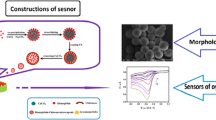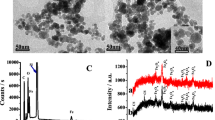Abstract
The authors describe a nanosized oxygen biosensor based on grafted starch particles with encapsulated hemoglobin (GS-Hb). Transmission electron microscopy showed the GS-Hb particles to have a typical diameter of 573 nm. UV–vis absorption spectra showed that the hemoglobin in GS-Hb retains its biological activity in terms of carrying and releasing oxygen. Cyclic voltammetric studies were performed with GS-Hb particles placed in a chitosan matrix on a glassy carbon electrode, revealing a pair of nearly reversible redox peaks. At a working potential of −0.40 V (vs. SCE), a linear response is found over the 0.97 μM to 0.35 mM oxygen concentration range, and the lower detection limit is 0.32 μM (~5 ppb; at an S/N ratio of 3). This range is wider than that produced when using red blood cells. In addition, the GS-Hb particles have a better oxygen-carrying ability, which may pave the way to the creation of oxygen carriers for use in transfusions.

A glassy carbon electrode modified with hemoglobin in starch particles in a chitosan matrix shows excellent amperometric response to oxygen and also displays improved oxygen-carrying capability (compared to red blood cells).





Similar content being viewed by others
References
Liu H, Duan C, Yang C, Shen W, Wang F, Zhu Z (2015) A novel nitrite biosensor based on the direct electrochemistry of hemoglobin immobilized on MXene-Ti3C2. Sensors Actuators B Chem 218:60–66. doi:10.1016/j.snb.2015.04.090
Sun W, Hou F, Gong S, Han L, Wang W, Shi F, Xi J, Wang X, Li G (2015) Direct electrochemistry and electrocatalysis of hemoglobin on three-dimensional graphene modified carbon ionic liquid electrode. Sensors Actuators B Chem 219:331–337. doi:10.1016/j.snb.2015.05.015
Mao S, Long Y, Li W, Tu Y, Deng A (2013) Core-shell structured Ag@C for direct electrochemistry and hydrogen peroxide biosensor applications. Biosens Bioelectron 48:258–262. doi:10.1016/j.bios.2013.04.026
Chen X, Wang Q, Wang L, Gao F, Wang W, Hu Z (2015) Imidazoline derivative templated synthesis of broccoli-like Bi2S3 and its electrocatalysis towards the direct electrochemistry of hemoglobin. Biosens Bioelectron 66:216–223. doi:10.1016/j.bios.2014.11.020
Lin M, Pan D, Hu X, Han H, Li F (2015) Titanium carbide nanoparticles/ion-exchange polymer-based sensor for catalytic stripping determination of trace iron in coastal waters. Sensors Actuators B Chem 219:164–170. doi:10.1016/j.snb.2015.05.034
Zhao R, Liu X, Zhang J, Zhu J, Wong DKY (2015) Enhancing direct electron transfer of glucose oxidase using a gold nanoparticle |titanate nanotube nanocomposite on a biosensor. Electrochim Acta 163:64–70. doi:10.1016/j.electacta.2015.02.098
Yu YY, Guo CX, Yong YC, Li CM, Song H (2015) Nitrogen doped carbon nanoparticles enhanced extracellular electron transfer for high-performance microbial fuel cells anode. Chemosphere 140:26–33. doi:10.1016/j.chemosphere.2014.09.070
Xu Q, Shen Y, Tang J, Xue MH, Jiang L, Hu X (2015) Electrochemical method assisted immobilization and orientation of myoglobin into biomimetic brij 56 film and its direct electrochemistry study. ACS Appl Mater Interfaces 7(21):11286–11293. doi:10.1021/acsami.5b01492
Guitian Oliveira N, Sirgado T, Reis L, Pinto LFV, da Silva CL, Ferreira FC, Rodrigues A (2014) In vitro assessment of three dimensional dense chitosan-based structures to be used as bioabsorbable implants. J Mech Behav Biomed 40:413–425. doi:10.1016/j.jmbbm.2014.09.014
Yang JL, Huang YJ, Gao CM, Liu MZ, Zhang XJ (2014) Fabrication and evaluation of the novel reduction-sensitive starch nanoparticles for controlled drug release. Colloids Surf, B 115:368–376. doi:10.1016/j.colsurfb.2013.12.007
Zhang JJ, Ma XX, Fan DD, Zhu CH, Deng JJ, Hui JF, Ma P (2014) Synthesis and characterization of hyaluronic acid/human-like collagen hydrogels. Mat Sci Eng C-Mater 43:547–554. doi:10.1016/j.msec.2014.07.058
Gu F, Li B-Z, Xia H, Adhikari B, Gao Q (2015) Preparation of starch nanospheres through hydrophobic modification followed by initial water dialysis. Carbohyd Polym 115:605–612. doi:10.1016/j.carbpol.2014.08.102
Subramanian SB, Francis AP, Devasena T (2014) Chitosan-starch nanocomposite particles as a drug carrier for the delivery of bis-desmethoxy curcumin analog. Carbohyd Polym 114:170–178. doi:10.1016/j.carbpol.2014.07.053
Mauricio MR, da Costa PG, Haraguchi SK, Guilherme MR, Muniz EC, Rubira AF (2015) Synthesis of a microhydrogel composite from cellulose nanowhiskers and starch for drug delivery. Carbohyd Polym 115:715–722. doi:10.1016/j.carbpol.2014.07.063
Collins RE (1961) Transport of gases through hemoglobin solution. Science (New York, NY) 133(3464):1593–1594. doi:10.1126/science.133.3464.1593
Bossi D, Giardina B (1996) Chapter 1 Red cell physiology. Mol Aspects Med 17(2):117–128. doi:10.1016/0098-2997(96)88343-9
Sharan M, Popel AS (2002) A compartmental model for oxygen transport in brain microcirculation in the presence of blood substitutes. J Theor Biol 216(4):479–500. doi:10.1006/jtbi.2002.3001
Yang R, Gao G, Liu T, Liu S, Li G (2007) Enhanced ability of hemoglobin to carry oxygen by salidroside. Electrochem Commun 9(1):94–96. doi:10.1016/j.elecom.2006.08.042
Wang XD, Wolfbeis OS (2014) Optical methods for sensing and imaging oxygen: materials, spectroscopies and applications. Chem Soc Rev 43(10):3666–3761. doi:10.1039/c4cs00039k
Pan ZQ, Xie J, Liu XJ, Bao N, Gu HY (2014) Direct electron transfer from native human hemoglobin using a glassy carbon electrode modified with chitosan and a poly(N, N-diethylacrylamide) hydrogel containing red blood cells. Microchim Acta 181(11–12):1215–1221. doi:10.1007/s00604-014-1222-9
Wang YH, Guo JW, Gu HY (2010) A novel nano-sized bionic function interface for enhancing the ability of red blood cells to carry oxygen. Microchim Acta 171(1–2):179–186. doi:10.1007/s00604-010-0392-3
Jia Y, Cui Y, Fei J, Du M, Dai L, Li J, Yang Y (2012) Construction and Evaluation of Hemoglobin-Based Capsules as Blood Substitutes. Adv Funct Mater 22(7):1446–1453. doi:10.1002/adfm.201102737
Ji N, Li XJ, Qiu C, Li GH, Sun QJ, Xiong L (2015) Effects of heat moisture treatment on the physicochemical properties of starch nanoparticles. Carbohydr Polym 117:605–609. doi:10.1016/j.carbpol.2014.10.005
Gao W, Sha B, Zou W, Liang X, Meng X, Xu H, Tang J, Wu D, Xu L, Zhang H (2011) Cationic amylose-encapsulated bovine hemoglobin as a nanosized oxygen carrier. Biomaterials 32(35):9425–9433. doi:10.1016/j.biomaterials.2011.08.046
Sun J, Huang Y, Shi Q, Chen X, Jing X (2009) Oxygen carrier based on hemoglobin/poly(L-lysine)-block-poly(L-phenylalanine) vesicles. Langmuir 25(24):13726–13729. doi:10.1021/la901194k
Dobrunz D, Toma AC, Tanner P, Pfohl T, Palivan CG (2012) Polymer nanoreactors with dual functionality: simultaneous detoxification of peroxynitrite and oxygen transport. Langmuir 28(45):15889–15899. doi:10.1021/la302724m
Laviron E (1979) General expression of the linear potential sweep voltammogram in the case of diffusionless electrochemical systems. J Electroanal Chem Interfacial Electrochem 101(1):19–28. doi:10.1016/S0022-0728(79)80075-3
Gu HY, Yu AM, Chen HY (2001) Direct electron transfer and characterization of hemoglobin immobilized on a Au colloid–cysteamine-modified gold electrode. J Electroanal Chem 516(1–2):119–126. doi:10.1016/S0022-0728(01)00669-6
Ren L, Dong J, Cheng X, Xu J, Hu P (2013) Hydrogen peroxide biosensor based on direct electrochemistry of hemoglobin immobilized on gold nanoparticles in a hierarchically porous zeolite. Microchim Acta 180(13–14):1333–1340. doi:10.1007/s00604-013-1064-x
Baghayeri M, Zare EN, Lakouraj MM (2014) Monitoring of hydrogen peroxide using a glassy carbon electrode modified with hemoglobin and a polypyrrole-based nanocomposite. Microchim Acta 182(3–4):771–779. doi:10.1007/s00604-014-1387-2
Pita M, Gutierrez-Sanchez C, Toscano MD, Shleev S, De Lacey AL (2013) Oxygen biosensor based on bilirubin oxidase immobilized on a nanostructured gold electrode. Bioelectrochemistry 94:69–74. doi:10.1016/j.bioelechem.2013.07.001
Haghighi B, Bozorgzadeh S (2011) Enhanced electrochemiluminescence from luminol at multi-walled carbon nanotubes decorated with palladium nanoparticles: a novel route for the fabrication of an oxygen sensor and a glucose biosensor. Anal Chim Acta 697(1–2):90–97. doi:10.1016/j.aca.2011.04.032
Zheng R-J, Fang Y-M, Qin S-F, Song J, Wu A-H, Sun J-J (2011) A dissolved oxygen sensor based on hot electron induced cathodic electrochemiluminescence at a disposable CdS modified screen-printed carbon electrode. Sensors Actuators B Chem 157(2):488–493. doi:10.1016/j.snb.2011.05.005
Lin Z, Liu Y, Chen G (2008) TiO2/Nafion film based electrochemiluminescence for detection of dissolved oxygen. Electrochem Commun 10(10):1629–1632. doi:10.1016/j.elecom.2008.08.015
Luo W, Abbas ME, Zhu L, Zhou W, Li K, Tang H, Liu S, Li W (2009) A simple fluorescent probe for the determination of dissolved oxygen based on the catalytic activation of oxygen by iron(II) chelates. Anal Chim Acta 640(1–2):63–67. doi:10.1016/j.aca.2009.03.024
Acknowledgments
This work was financially supported by the National Natural Science Foundation of China (Grant numbers: 21475070; 21175075), the Natural Science Foundation of Jiangsu Province (Grant number: BK2011047, BK2012651), the Priority Academic Program Development of Jiangsu Higher Education Institutions (PAPD), and the 226 Scientific Research Project of Nantong City.
Author information
Authors and Affiliations
Corresponding authors
Additional information
Xiaojun Liu and Zhongqin Pan contributed equally to this work.
Electronic supplementary material
Below is the link to the electronic supplementary material.
ESM 1
(DOC 320 kb)
Rights and permissions
About this article
Cite this article
Liu, X., Pan, Z., Dong, Z. et al. Amperometric oxygen biosensor based on hemoglobin encapsulated in nanosized grafted starch particles. Microchim Acta 183, 353–359 (2016). https://doi.org/10.1007/s00604-015-1655-9
Received:
Accepted:
Published:
Issue Date:
DOI: https://doi.org/10.1007/s00604-015-1655-9




